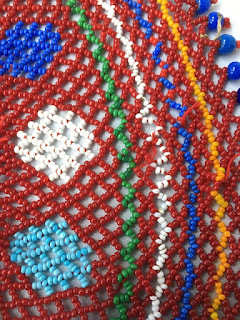 |
| 'Krvyulka' in the round |
I was thrilled when Orysia Sopinka asked me if I could restore her mother’s ‘kryvulka’, a precious keepsake and a piece of her cultural identity.
It was a privilege to get up close, to study the thread paths of an incredible traditional ‘kryvulka’ beadwoven by young Eva Vakyriak (1920-2014). This was the ultimate adornment for the Lemkos, a ethnographic Ukrainian group and Eva made her own for festive occasions.
 |
Netted section ruffles when 'krvyulka' is straightened
|
Eva would have beaded this as a teenager in her village of Chystohorb (Czystogarb), near Komancha (Komancza) in today’s Poland. In 1939 she left home forever to be an Osterbeiter, a foreign slave worker in Germany.
Orysia brought this to me in January 2020. Right away I said this ‘kryvulka’ has a lot of stories it could tell. So, here is what I gleaned from my restoration experience.
A ‘kryvulka’, the local term in Komancha, is a ‘kryza’, a broad collar comprising of four distinct sections:
A - ‘polotnya’ - top choker-like band usually, a right angle weave, using two needles or one today in the R.A.W. stitch.
B - vertical netting with rhomb motifs. This then attaches to the ‘polotnya’ choker.
C - horizontal ‘zigzags’, rows of 5 beads going through the center of the previous row bead net to expand the width of the broad collar one colored row at a time.
D - ‘gombychky’, large accent beads used to trim along the lower collar edge.
Eva ran out of large blue ‘gombychky’ beads and finished the trim with blue seed bead picots. She added a printed fabric to encase both ends so she could add a button and snap closure so her ‘kryvulka’ wears comfortably as a collar. Without this, the wide beaded net ends would fold over forward while wearing.
 |
| Fabric encased ends |
The best way of learning how something is constructed or beadwoven is to have to repair it! While it may seem sad, this is the best way to learn!
The entire ‘kryvulka’ was beaded with a red thick thread. Because of the tight tension, one wouldn’t notice missing beads or tears in places. Previous repairs would be with whatever beads colors were available. It was a challenge to repair in places because of the thickness of the thread/small size of the bead hole. Many fine needles broke in the process. I finally understood why there were knots and thread tails in places. It was a way to secure new thread, fill in beads and try to discreetly reinforce the addition.
I started repairing the netted motifs. One had to carefully add two beads above and below the mesh points in the vertical netting. Once the green rhomb net was repaired, I repaired a few more tears around.
By reconstructing this collar, I could clearly see how the ‘polotnya’ choker was attached to the top of the netted rhombs. It’s as if they were zipped together.
Though the horizontal zigzags are created with 5 beads as you expand the broad collar, when you repair tears, you simply insert two beads in between points as seen in the white row.
Similarly for the blue zigzag row. In a previous repair red seed beads were inserted. Better red than have a tear! I wanted to change them back to a distinct blue row.
The fabric closure needed cleaning so I gently ‘washed’ it with a cotton ball with detergent. When I saw the print lightening, I stopped and let it air dry.
The thread loop was badly frayed so I used a red cord to make a new loop. Thank goodness I remembered hand sewing basics my mother taught me!!
I sewed on the blue button with red thread and reinforced the snaps on the fabric tab.
This was it for the reconstruction, but I wanted to figure out how to bead a ‘polotnya’ with extra 2-bead stack rows meant to be joined to the rhomb net.
Instead or using the traditional two-needle method, I tried beading the center row of diamond motifs using Right Angle Weave (R.A.W.) with one needle. You can see my turn-around progress and motifs.
It took a while to figure out how to make 2-bead white stacks. Then how to add a single red bead to connect the stacks. Afterwards, I added a single red bead between the red bead edge. This created a solid red line.
Next was a row of 2-bead green stacks. These went faster using the same methodology, as above.
Lastly, a row of 2-bead yellow stacks. Same start and solid red finish.
At this point, I was so happy “I got it!”. I photographed this from every angle and asked Orysia permission to use her ‘kryvulka’ with my R.A.W. reproduction for the cover of my personal Facebook page. I am a beader and I love red with intricate motifs.
On June 15th I completed a massive update on
Rypan Designs website on occasion on my 25th anniversary of teaching.
July 1st, Canada Day 2020, I delivered the reconstructed ‘kryvulka’ to Orysia. What she showed me will be in my next blog. Here’s a sneak-peak.
 |
| Lemko ‘kryvulka’ and ‘leybychok’ (vest) beaded by young Eva Vakyriak. |



























































